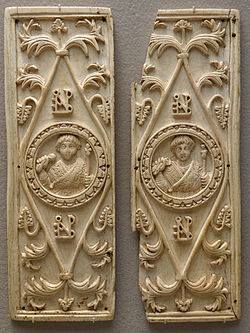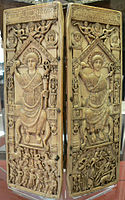
Anastasius I Dicorus was Eastern Roman emperor from 491 to 518. A career civil servant, he came to the throne at the age of 61 after being chosen by the wife of his predecessor, Zeno. His reign was characterised by reforms and improvements in the empire's government, finances, economy and bureaucracy. He is noted for leaving the empire with a stable government, reinvigorated monetary economy and a sizeable budget surplus, which allowed the empire to pursue more ambitious policies under his successors, most notably Justinian I. Since many of Anastasius' reforms proved long-lasting, his influence over the empire endured for many centuries.

A diptych is any object with two flat plates which form a pair, often attached by hinge. For example, the standard notebook and school exercise book of the ancient world was a diptych consisting of a pair of such plates that contained a recessed space filled with wax. Writing was accomplished by scratching the wax surface with a stylus. When the notes were no longer needed, the wax could be slightly heated and then smoothed to allow reuse. Ordinary versions had wooden frames, but more luxurious diptychs were crafted with more expensive materials.
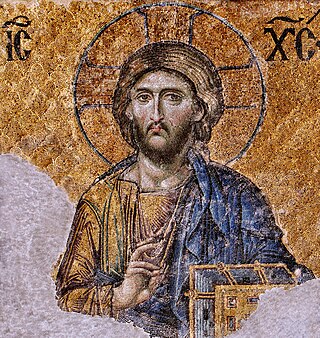
Byzantine art comprises the body of artistic products of the Eastern Roman Empire, as well as the nations and states that inherited culturally from the empire. Though the empire itself emerged from the decline of western Rome and lasted until the Fall of Constantinople in 1453, the start date of the Byzantine period is rather clearer in art history than in political history, if still imprecise. Many Eastern Orthodox states in Eastern Europe, as well as to some degree the Islamic states of the eastern Mediterranean, preserved many aspects of the empire's culture and art for centuries afterward.

A consul was the highest elected public official of the Roman Republic. Romans considered the consulship the second-highest level of the cursus honorum—an ascending sequence of public offices to which politicians aspired—after that of the censor, which was reserved for former consuls. Each year, the Centuriate Assembly elected two consuls to serve jointly for a one-year term. The consuls alternated each month holding fasces when both were in Rome. A consul's imperium extended over Rome and all its provinces.
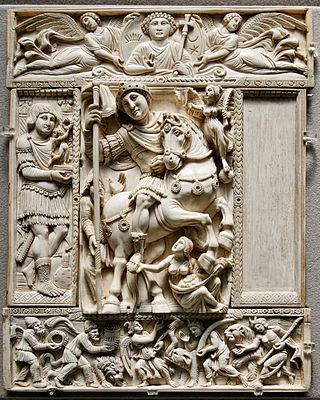
The Barberini ivory is a Byzantine ivory leaf from an imperial diptych dating from Late Antiquity, now in the Louvre in Paris. It represents the emperor as triumphant victor. It is generally dated from the first half of the 6th century and is attributed to an imperial workshop in Constantinople, while the emperor is usually identified as Justinian, or possibly Anastasius I or Zeno. It is a notable historical document because it is linked to queen Brunhilda of Austrasia. On the back there is a list of names of Frankish kings, all relatives of Brunhilda, indicating her important position. Brunhilda ordered the list to be inscribed and offered it to the church as a votive image.

Anicius Faustus Albinus Basilius was a high official of the Eastern Roman Empire and the last ordinary consul of Roman history, holding the office alone in 541.

Flavius Felix, sometimes erroneously called Constantius Felix, was a general of the Western Roman Empire, who reached the prominent rank of patrician before being killed probably by order of Aetius. For his consulate, in 428, he issued some consular diptychs, one of which has been preserved until modern times.

Anicia Juliana was a Late Antique Roman imperial princess, wife of the magister militum of the eastern Roman empire, Areobindus Dagalaiphus Areobindus, patron of the great Church of St Polyeuctus in Constantinople, and owner of the Vienna Dioscurides. She was the daughter of the Roman emperor Olybrius and his wife Placidia, herself the daughter of the emperor Valentinian III and Licinia Eudoxia, through whom Anicia Juliana was also great-granddaughter of the emperor Theodosius II and the sainted empress Aelia Eudocia. During the rule of the Leonid dynasty and the rise of the later Justinian dynasty, Anicia Juliana was thus the most prominent member of both the preceding imperial dynasties, the Valentinianic dynasty established by Valentinian the Great and the related Theodosian dynasty established by Theodosius the Great.

Euphemia, born Lupicina, was an Empress of the Eastern Roman Empire by marriage to Justin I.
Flavius Olybrius was an aristocrat of the Eastern Roman Empire and a consul for the year 491. He is sometimes referred to as "Olybrius Junior" in the sources, probably referencing his young age. Olybrius was through his mother Anicia Juliana a descendant of the conjoined Valentinianic and Theodosian dynasties, and the grandson of the emperor Olybrius and the great-grandson of Western Roman Emperor Valentinian III. He was also a potential augustus on the death of the Eastern Roman Emperor Zeno of the Leonid dynasty.

FlaviusAreobindus Dagalaifus Areobindus was an Eastern Roman general and politician. The scion of a distinguished line, he led troops in the Anastasian War, and served as consul in 506. During an urban riot in 512, Areobindus evaded a mob which wanted to force a change of government by proclaiming him emperor. He died soon after.

The Poet and Muse diptych is a Late Antique ivory diptych that appears to commemorate, and to flatter, the literary pursuits of the aristocrat who commissioned it, so that it stands somewhat apart from the consular diptychs that were carved for distribution to friends and patrons when a man assumed the consular dignity during the later Roman Empire. The original inscription in this example, unusually, will have been carried out on the borders of the reverse side, which was infilled with a layer of wax for writing on, the ivory diptych being a very grand example of a wax tablet; the inscription has not survived, so there can be no way to identify the writer for whom it was made. In the literature that has accumulated about this diptych, various prominent figures have been offered as candidates: Ausonius, Boethius, and Claudian, and even earlier figures, like Ennius and Seneca, with whom the donor wished to be associated
The gens Anicia was a plebeian family at ancient Rome, mentioned first towards the end of the fourth century BC. The first of the Anicii to achieve prominence under the Republic was Lucius Anicius Gallus, who conducted the war against the Illyrians during the Third Macedonian War, in 168 BC.
Flavius Areobindus was a general of the Eastern Roman Empire, second generation of Barbarian incorporation of Gothic origin, who became commander in chief of the East. He led battles and conquests on multiple fronts of the allegedly stable Eastern Roman Empire. In addition, due to his military efforts, he was awarded the consulate in 434 along with his co-consul, Aspar. He would hold his magister millitum position until his death in 449. He is the beginning of a distinguished line of nobles through his group’s admission into the Eastern Roman Empire.
Pompeius was a politician of the Eastern Roman Empire and nephew of the Emperor Anastasius I. His family gained political prominence with the accession of Anastasius. Pompeius was consul in 501, and was elevated to the patricianate, probably by Anastasius. He held military office, serving in the Iberian War. He married a woman named Anastasia, and had at least one son. In 532, Pompeius' brother Hypatius was acclaimed emperor by the rioters during the Nika riots; after the riots were put down, both Hypatius and Pompeius were executed.
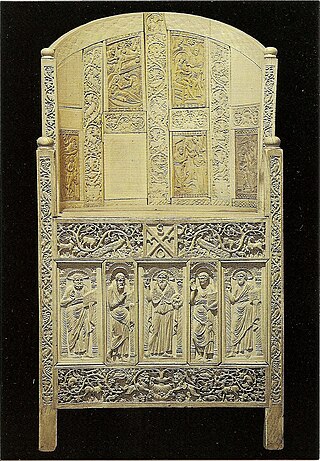
The Throne of Maximian is a cathedra that was made for Archbishop Maximianus of Ravenna and is now on display at the Archiepiscopal Museum, Ravenna. It is generally agreed that the throne was carved in the Greek East of the Byzantine Empire and shipped to Ravenna, but there has long been scholarly debate over whether it was made in Constantinople or Alexandria.
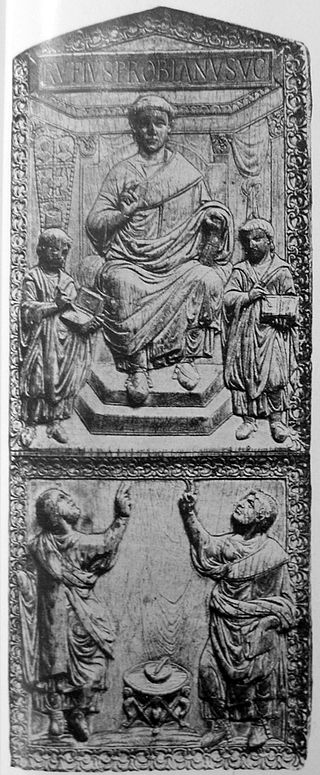
Rufius Probianus was a vicarius of the Late Roman Empire. He is known from an ivory diptych on which he appears with his right hand lifted in an oratorical gesture to indicate that he is either speaking or has the right to speak.
(Decius) Paulinus was a Roman aristocrat and politician who served as the last consul of the Roman Senate. After his term, consuls would be appointed in the East alone.
The gens Rufia, occasionally spelled Ruffia, was a minor plebeian family at ancient Rome. Members of this gens are not mentioned in history until imperial times, and they achieved little prominence until the late third century, from which time the family rose in importance, gaining the consulship on a number of occasions from the time of Constantine the Great to that of Justinian, and frequently holding the post of praefectus urbi.
In Ancient Rome, a mappa was a white cloth or napkin used by the presiding magistrate to signal the start of a chariot race at a hippodrome by tossing it down into the arena. Its use is attested to beginning in the early years of the Roman Empire, though chariot races pre-date it by hundreds of years. Any piece of white cloth could serve as a mappa. Roman consuls were often depicted on coins holding a mappa in their raised right hand, and the mappa therefore became represented as an item of imperial regalia.
